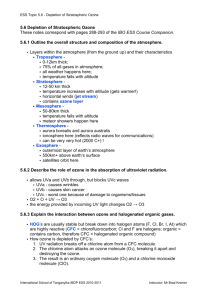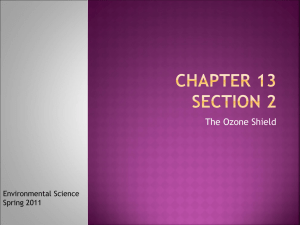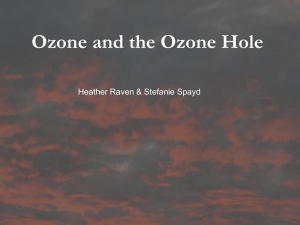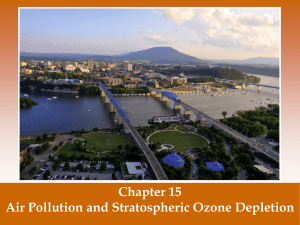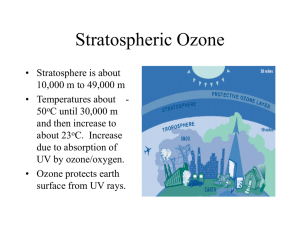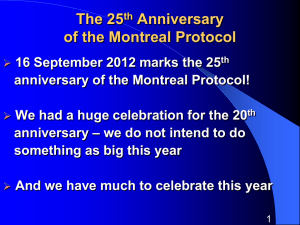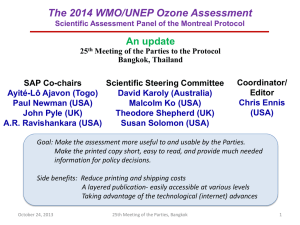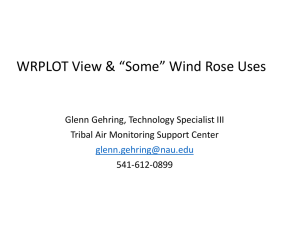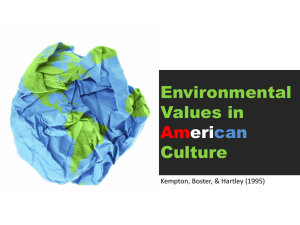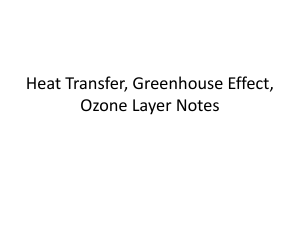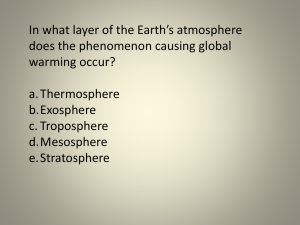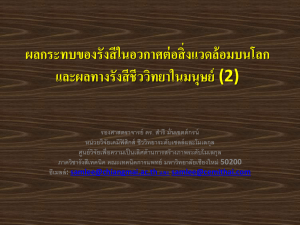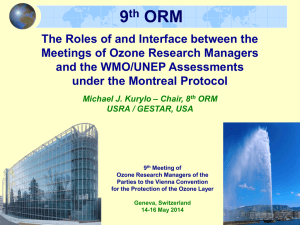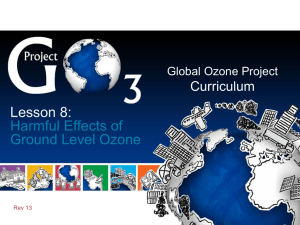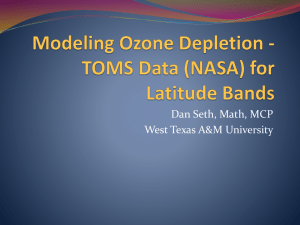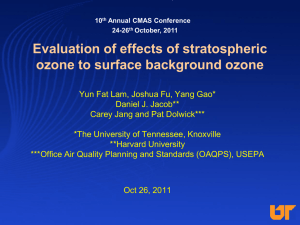Ozone - La Cañada Unified School District
advertisement
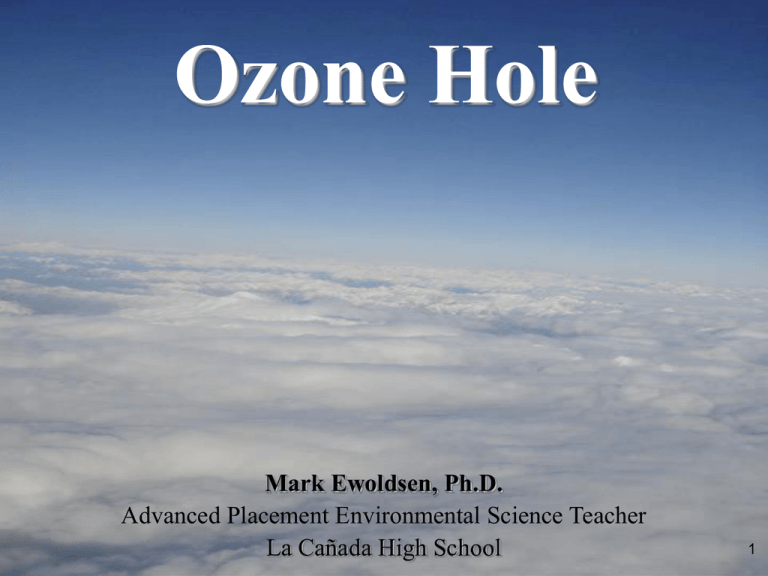
Ozone Hole Mark Ewoldsen, Ph.D. Advanced Placement Environmental Science Teacher La Cañada High School 1 Two Atmosphere Layers • Stratosphere is above Troposphere –Ozone Layer blocks UV radiation • Troposphere is where we live –Weather occurs here • 72% of all air is below the cruising altitude of commercial airliners (33000 ft) 2 Stratospheric Ozone (Good) vs. Tropospheric Ozone (Bad) 3 Ozone – Two Faces • Stratosphere – Good Ozone –Blocks UV radiation –Hole caused by depletion due to CFC’s • Troposphere – Bad Ozone –Pollution • Photochemical smog • Eye irritant 4 Harmful effects of UV radiation • Skin cancer such as melanoma(ultraviolet radiation can destroy acids in DNA) • Suppression of immune systems 5 matrix.ucdavis.edu/tumors/tradition/ gallery-ssmm.html Harmful effects of UV radiation • Skin cancer such as melanoma(ultraviolet radiation can destroy acids in DNA) • Suppression of immune systems • Cataracts and sun burning 7 www.snec.com.sg/clinical_services/ cataract.asp http://www.wep.org.au/info/files/images/Amelia_and_the_kids.jpg Harmful effects of UV radiation • Skin cancer such as melanoma(ultraviolet radiation can destroy acids in DNA) • Suppression of immune systems • Cataracts and sun burning • Adverse impact on crops and animals • Reduction in the growth of ocean phytoplankton • Cooling of the Earth's stratosphere and possibly some surface climatic effect • Degradation of paints and plastic material 10 Good Ozone 13 Ozone Formation • Ozone forms a layer in the • O2 + hv O + O stratosphere, thinnest in the tropics (around • (1) O + O2 O3 the equator) and denser towards • wavelength ~ 240 nm the poles. http://www-imk.fzk.de/topoz-iii/ataglanz/ozonbild.html http://www-imk.fzk.de/topoz-iii/ataglanz/ozonzerst.html Natural Ozone Hole • Winter = no sunlight • Air in the polar vortex can get very cold -80C • Special clouds called Polar Stratospheric Clouds form as nitric acid trihydrate • PSCs are crucial for ozone loss to occur Since there is no sunlight, the air within the polar vortex can get very cold The ozone hole builds up over the winter months, peaking at around September and breaking up again by December, this data set from 2005 July August September October November December Destroying Good Ozone 19 20 Destroying Good Ozone • Chloroflourocarbons were first created in 1928 as non-toxic, non-flamable refrigerants, and were first produced commercially in the 1930's by DuPont • In 1974, a laboratory study demonstrated the ability of CFC's to catalytically breakdown Ozone in the presence of high frequency UV light • Cl + O3 -> ClO + O2 ClO + O3 ---> 2 O2 + Cl • In a 1985, a study summarized data that had been collected by the British Antartic Survey showing that ozone levels had dropped to 10% below normal January levels for Antarctica. • http://www.nas.nasa.gov/About/Education/Ozone/history.html 21 A single chlorine atom removes about 100,000 ozone molecules before it is taken out of operation by other substances 22 The frozen crystals that make up polar stratospheric clouds provide a surface for the reactions that free chlorine atoms in the Antarctic stratosphere Ultraviolet light hits a chlorofluorocarbon (CFC) molecule, such as CFCl3, breaking off a chlorine atom and leaving CFCl2. Sun Cl Cl C Cl F UV radiation Once free, the chlorine atom is off to attack another ozone molecule and begin the cycle again. Cl Cl O The chlorine atom attacks an ozone (O3) molecule, pulling an oxygen atom Cl off it and leaving an oxygen O molecule (O2). O O The chlorine Cl atom and the O oxygen atom join to form a chlorine O monoxide molecule (ClO) O O A free oxygen atom pulls the oxygen atom off the chlorine monoxide molecule to form O2. Cl O O http://www.clas.ufl.edu/users/dlsmith/Lecture_11.html http://www.mmscrusaders.com/newscirocks/ozone/cfc.jpg 26 27 Montreal Protocol • An international treaty designed to protect the ozone layer – phasing out production of number of substances believed to be responsible for ozone depletion – Effective January 1, 1989 – Five revisions • • • • • 1990 (London) 1992 (Copenhagen) 1995 (Vienna) 1997 (Montreal) 1999 (Beijing) 28 Area of North America Area of Antarctica 30

